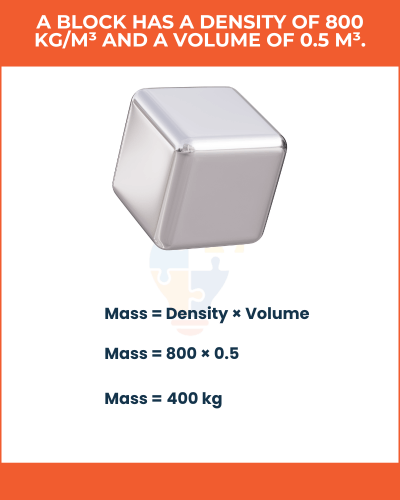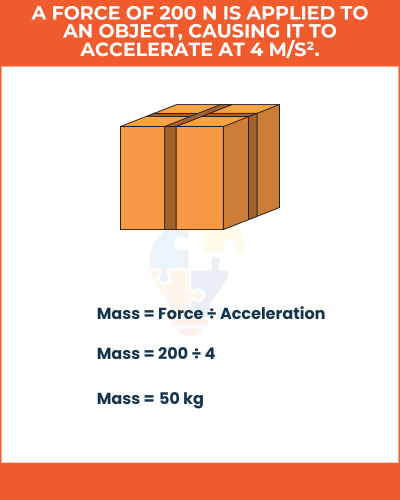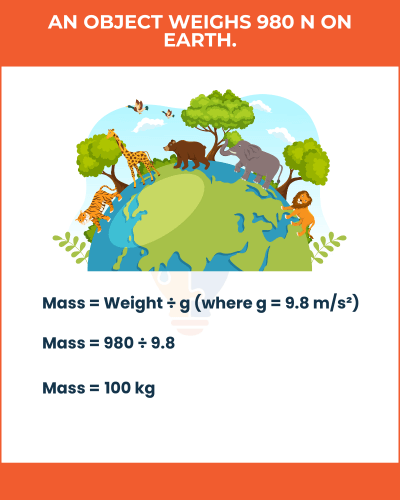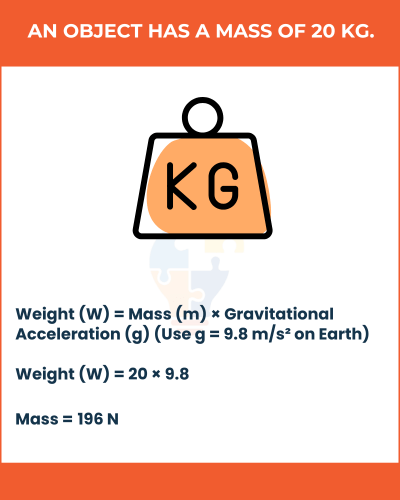Not sure how mass and weight are different? This guide will make it easy to understand.
Mass is the amount of matter in an object. Weight is the pull of gravity on that mass. Knowing the difference helps you understand science better.
Let’s take a closer look at what is mass and weight and how they are not the same.
What is mass?
"Mass is the amount of matter or "stuff" in an object. It doesn’t change, no matter where the object is."
SI Unit of Mass:
"The SI unit of mass is the kilogram (kg)."
“Get success in exams with our 1-on-1 physics tutors.”
How to Calculate Mass?
In physics, an object’s mass can be found using different formulas, depending on the available information:
- Using Density and Volume

- Using Force and Acceleration

- Using Weight and Gravitational Acceleration

What is Weight?
"Weight is the force caused by gravity pulling on an object. It depends on the object's mass and the strength of the gravitational pull in that location."
SI Unit of Weight:
"The SI unit of weight is the newton (N)."
“Book a free assessment for physics tutors.”
How to Calculate Weight?
To calculate weight, you can use the formula:
Weight (W) = Mass (m) × Gravitational Acceleration (g)

Differene Between Mass and Weight
Learn the simple differences between mass vs weight!
| Aspect | Mass | Weight |
|---|---|---|
| Definition | The amount of matter in an object. | The force exerted by gravity on an object’s mass. |
| Unit | Kilograms (kg), grams (g), or pounds (lb). | Newtons (N), or pounds-force (lbf) in some contexts. |
| Constant or Variable | Constant, remains the same regardless of location. | Variable, changes with gravitational acceleration. |
| Measurement Tool | Measured with a balance, scale, or inertial balance. | Measured using a spring scale or force meter. |
| Depends On | Depends only on the object’s matter, independent of gravity. | Depends on the object’s mass and the strength of gravity. |
| Nature | Scalar quantity (has magnitude but no direction). | Vector quantity (has both magnitude and direction, downward). |
| Direction | None, as it is a scalar. | Always directed towards the center of the gravitational source. |
| Value on Earth vs. Moon | Same on Earth and Moon. | Lower on the Moon (about 1/6th of the weight on Earth). |
| Effect of Gravity | Not influenced by changes in gravity. | Directly influenced by changes in gravity (stronger gravity means more weight). |
| Use in Physics | Represents inertia, which is the resistance to changes in motion. | Represents the force due to gravity acting on a mass. |
| Role in Newton’s Laws | Related to Newton’s First Law of Motion (inertia). | Related to Newton’s Second Law of Motion (F = ma). |
| Effect in Space | Remains unchanged in space. | Approaches zero in a weightless environment, such as orbit. |
| Relation to Density | Can be calculated using mass = density × volume. | Not related to density; weight is affected by gravitational pull. |
| Typical Example | A 10 kg object has a mass of 10 kg whether on Earth, Moon, or in space. | A 10 kg object weighs 98 N on Earth but only 16 N on the Moon. |
| Interchangeability | Cannot be interchanged with weight; they are different concepts. | Sometimes mistakenly referred to as “weight” in everyday language. |
| Common Misconception | People often confuse mass with weight. | Often used to describe “heaviness” when it’s actually a force. |
| Scientific Understanding | Fundamental property of an object that remains constant. | A derived quantity based on mass and gravitational force. |
| Interaction with Forces | Does not include external forces; purely an intrinsic property. | Includes external forces like gravitational pull, which varies by celestial body. |
| Acceleration Effects | Independent of acceleration; inertial mass remains constant in all frames of reference. | Directly proportional to gravitational acceleration; weight increases as acceleration rises. |
| Gravitational Constant | Mass is the same regardless of variations in gravitational constant. | Weight changes if the gravitational constant of a location changes (e.g., on another planet). |
| Effect in Free Fall | Mass remains constant during free fall. | Weight becomes negligible during free fall due to apparent weightlessness. |
| Effect of Air Resistance | Unaffected by air resistance. | Apparent weight can change due to opposing forces like air resistance. |
| Thermal Effects | Not affected by temperature changes. | No direct thermal influence; weight only changes with gravity or mass alterations. |
How Does Gravity Affect Weight in Different Locations?
Gravity varies across different planets and even across Earth’s surface.
- On the Moon, gravity is 1/6th of Earth’s gravity, so an object weighs less.
- In space, astronauts experience weightlessness because there is no gravitational pull.
- On high mountains, weight decreases slightly due to lower gravitational force.
Why Do Scientists Use Mass Instead of Weight in Physics?
Mass is a constant property, while weight changes with gravity.
- Scientists use mass for accurate calculations in experiments.
- Engineers rely on mass to design bridges, vehicles, and aircraft.
- The kilogram (kg) is the standard SI unit used in the UK and worldwide.
Why Choose Tutorhelpme Physics Tutors
Experienced Tutors: Our physics tutors are knowledgeable and skilled in simplifying complex topics, helping students understand concepts clearly.
Personalized Lessons: We tailor each lesson to meet the student’s unique needs, focusing on areas where they need the most help.
Flexible Online Learning: Our online tutoring sessions offer convenience and flexibility, allowing students to learn from the comfort of their own homes.
Exam Preparation: We provide targeted support for exams, helping students improve problem-solving skills and boosting their confidence.
Practical Approach: We use real-life examples and hands-on activities to make physics more relatable and easier to grasp.
Continuous Feedback: Our tutors give regular feedback and progress updates, ensuring that students stay on track.
Affordable Rates: We offer competitive pricing without compromising on the quality of tutoring services.
Read More How Much Does a Chemistry Tutor Cost in 2024?
FAQ’s
Is gram mass or weight?
Gram is a unit of mass, not weight. It measures the amount of matter, independent of gravity’s influence.
How much weight is a mass?
Weight equals mass multiplied by gravitational acceleration. On Earth, weight (N) = mass (kg) × 9.8 m/s² (gravitational acceleration).
Is ton a weight or mass?
Ton is primarily a unit of mass. However, it is sometimes used to express weight in everyday contexts.
How does weightlessness affect astronauts?
UK astronauts, like Tim Peake, experienced weightlessness in space due to the absence of gravity. This causes muscle loss and bone density reduction, requiring astronauts to exercise regularly.
Why does weight change at different points on Earth?
Earth is not a perfect sphere, so gravitational strength varies slightly across locations.
Weight is slightly higher at the poles due to stronger gravity.
Weight is lower at the equator because centrifugal force reduces gravity’s effect.
How does mass affect sports performance?
Rugby players rely on mass for greater impact during tackles.
Sprinters benefit from lower mass for faster acceleration.
Weight categories exist in boxing and weightlifting to ensure fair competition.

